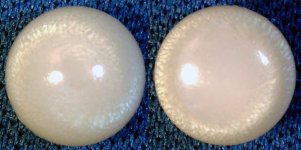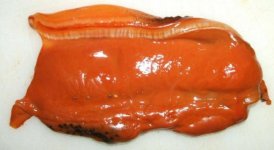Hats off to Jeremy Norris!
Now...acting the contrarian...is that a blister pearl or a ridge of nacre initiated by a worm? Is there a distinction?
This question has been rolling around in my mind as well.
While pearls can form in many parts an animal, my studies indicate the greatest incidence are proximal. This is usually due to an acid-base imbalance in that part of the tissue or the blood itself, where crystalization can occur, for whatever reason.
The attatched photo of a mantle section, supports this theory.
I have observed single specimens with 1000s of micro pearls throughout the entire mantle, indicating chronic imbalances in blood chemistry.
In a minority of cases, pearls are formed by injury, irritants or parasites.
Regarding this particular nautilus, the formation has the appearance of being distal, but is likely proximal, because of parasitazation from the outside inward.
Scale worms (Arctonae vittata) are commonly present in gastropods, namely Gumboot Chitons (Cryptochiton stelleri), Keyhole Limpets (Diodora aspera) and some seastars. Having a shell, this relationship is likely in the nautilus as well. Perhaps someone with hands on experience with live nautilus specimens could elaborate further.
Ed Ricketts best describes this relationship: "The length of the worm, considering the size of the host is remarkable, and the worm has to curl around the mantle so completely that it's ends almost touch. Even more remarkable, perhaps, is the response this worm gives when it's host is attacked by by the predatory seastar Pisaster ochraceus. The scale worm, as if understanding that it's host's demise would also be it's own, seeks out the seastar's tube feet, bites them and usually causes the seastar to loosen it's grip and withdraw."
While the relationship between worms and their hosts is often described as commensal (a form of symbiosis in which one organism derives a benefit while the other is unaffected), it would appear to be mutual in this case.
I have never observed a live nautilus, so I'm merely being speculative, but it's seems apparent from these photos that an immature scale worm is the underlying factor in the formation of the blister. Likewise, occurring in the latter stages of the natilus' life.



